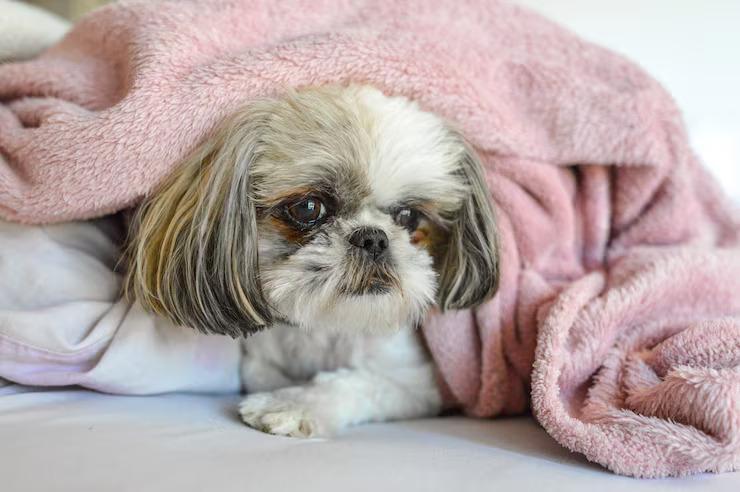Breeding a Lhasa Apso is both rewarding and delicate. These small but resilient dogs require proper timing, health checks, and responsible planning to ensure safe pregnancies and healthy puppies. This Lhasa Apso Breeding Guide covers everything you need to know, from understanding the heat cycle to knowing the ideal breeding age and expected litter size.
Understanding the Lhasa Apso Heat Cycle
The heat cycle is one of the most crucial aspects of the Lhasa Apso Breeding Guide because it determines when your dog is fertile and ready for mating.
Key Stages of the Heat Cycle
A typical Lhasa Apso heat cycle has four stages:
-
Proestrus (7–10 days): Swelling, spotting, males show interest.
-
Estrus (5–9 days): The fertile breeding period.
-
Diestrus (2 months): Signs disappear; pregnancy may occur.
-
Anestrus (4–6 months): The resting phase.
Signs Your Lhasa Apso Is in Heat
Common indicators include:
- Flagging the tail to attract males
- Increased urination
- Red or swollen vulva
- Affectionate or restless behavior
How Long the Heat Cycle Lasts
On average, a Lhasa Apso’s heat cycle lasts 2–3 weeks and occurs twice a year, although some may cycle every eight months.
Best Breeding Age for Lhasa Apsos
Choosing the right breeding age is critical in the Lhasa Apso Breeding Guide to prevent health complications.
Lhasa Apso Breeding Age Chart
| Age | Breeding Suitability |
|---|---|
| < 1 Year | Unsafe; not fully matured |
| 1–1.5 Years | Borderline; depends on development |
| 1.5–3 Years | Ideal breeding age |
| 4–6 Years | Still safe with veterinary approval |
| 7+ Years | Risky; breeding not recommended |
Physical and Behavioral Readiness Indicators
Your Lhasa Apso may be ready for breeding if she:
- Maintains a stable weight
- Shows consistent heat cycles
- Exhibits maternal tendencies
- Has no congenital health issues
RECOMMENDED:
-
Lhasa Apso Price in Nigeria (2025): Puppies for Sale in Lagos & Port Harcourt
-
Must-Have Dog Medications and Supplements: What to Give, When and Why
-
Lhasa Apso Price in Lagos, Nigeria: Lifespan, Temperament, and Buyer’s Guide
Risks of Breeding Too Early or Too Late
According to AKC breeding guidelines, early breeding may cause:
- Underdeveloped reproductive organs
- Smaller litter sizes
Late breeding increases risks of:
- Difficult labor (dystocia)
- Low fertility
- Genetic abnormalities
How Many Puppies Can a Lhasa Apso Have?
Average Litter Size and What Influences It
A healthy Lhasa Apso typically has 3–5 puppies per litter, although some may have up to 6 or 7. Litter size depends on:
- Age of the mother
- Heat cycle timing
- Genetic history
- Overall health
First-Time Lhasa Apso Pregnancy Expectations
First litters are usually smaller—often 2–3 puppies. This is normal for small breeds.
Factors Affecting Litter Health and Size
- Nutrition quality
- Stress levels
- Proper timing during estrus
- Stud fertility
Essential Health & Care During Breeding
Health is at the center of any Lhasa Apso Breeding Guide.
Pre-Breeding Health Checks
Recommended tests include:
- Brucellosis screening
- Genetic testing for progressive retinal atrophy (PRA)
- Hip evaluations (OFA)
- Heart examination
Nutrition Requirements During Heat and Pregnancy
High-quality diets with:
- Omega-3 fatty acids
- Proper protein levels
- Prenatal supplements (only with vet approval)
Exercise, Comfort, and Environmental Care
- Avoid strenuous exercise
- Provide a quiet environment
- Keep her hydrated and stress-free
Preparing for a Lhasa Apso Pregnancy
Mating Best Practices
- Mate on days 10–14 of the heat cycle
- Use a proven stud with genetic clearance
- Consider two ties 48 hours apart for best success
Early Pregnancy Signs in Lhasa Apsos
- Mild appetite changes
- Increased affection
- Slight weight gain
- Pinkening of the nipples (around week 3)
Creating a Safe Whelping Area
- Use washable bedding
- Keep the room warm (26–28°C)
- Provide privacy
Caring for a Pregnant Lhasa Apso
Week-by-Week Pregnancy Care Tips
Weeks 1–3: Light exercise, small balanced meals
Weeks 4–6: Increase food portions, avoid heavy play
Weeks 7–9: Prepare whelping box, reduce stress, monitor temperature
Common Complications to Watch For
- Eclampsia
- Miscarriage
- Dystocia
- Low calcium levels
When to Contact a Veterinarian
- Prolonged labor
- Heavy bleeding
- No puppy after 2 hours of active straining
Whelping and Post-Birth Care
Signs Labor Is Starting
- Nesting
- Drop in temperature below 37.2°C
- Restlessness
- Refusing food
What to Expect During Delivery
- Puppies usually arrive 20–60 minutes apart
- Entire labor may last 3–8 hours
Caring for Newborn Puppies and the Mother
- Ensure puppies latch immediately
- Keep the area warm
- Monitor mother for postpartum infection
Responsible Breeding & Ethical Considerations
Genetic Testing and Health Screening
Prevent hereditary issues like:
- Luxating patella
- PRA
- Allergies
Avoiding Overbreeding
Breed your Lhasa Apso no more than once a year to maintain health.
Choosing Reputable Studs and New Puppy Owners
- Ensure studs have strong lineages
- Screen owners for responsible care
Ensuring a Safe and Healthy Breeding Journey
This Lhasa Apso Breeding Guide shows that responsible breeding requires knowledge, timing, and attention to health. By understanding the heat cycle, ideal breeding age, and expected litter size, you’ll give your Lhasa Apso the best chance at a safe pregnancy and healthy puppies.
Ready to Breed Your Lhasa Apso Safely?
Breeding a Lhasa Apso requires expert guidance, proper timing, and professional veterinary support. At Dulham Veterinary Clinic, we help with pet adoption & provide full reproductive care, from heat cycle monitoring to pregnancy checkups, genetic screening, whelping support, and newborn puppy care.
Whether you’re a first-time breeder or experienced, our team ensures your Lhasa Apso stays healthy, safe, and stress-free throughout the breeding journey.
Book a breeding consultation with Dulham Veterinary Clinic today and give your Lhasa Apso the expert care she deserves.
Phone Us
0806 632 9826
Visit Us
No 23 Crown Court Estate 2, Orunbe close , Oniru. Victoria Island, Lagos.
No. 3 Isiokpo Street, Phalga, Port Harcourt
Mail Us
help@dulhamvetclinic.com
Join our Whatsapp Community – learn from other pet parents, and be the first to know about exclusive offers. Click to join the group
FAQs on Lhasa Apso Breeding Guide
1. What age can a Lhasa Apso safely get pregnant?
Most vets recommend breeding at 18–24 months, once growth plates and reproductive organs are fully developed.
2. How often does a Lhasa Apso go into heat?
Typically twice a year, though some cycle every 8–9 months.
3. How many puppies does a Lhasa Apso have in a first litter?
First-time mothers usually have 2–3 puppies, slightly fewer than later litters.
4. How long is a Lhasa Apso pregnant?
The average gestation period is 58–63 days, similar to most small breeds.
5. What are the signs of a healthy pregnancy in a Lhasa Apso?
Steady weight gain, healthy appetite, calm behavior, and pinkened nipples are normal indicators.

